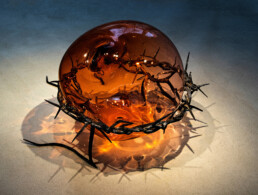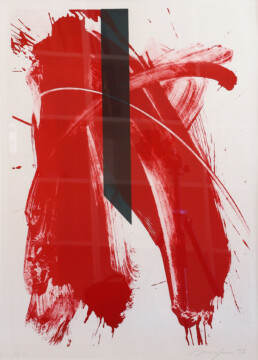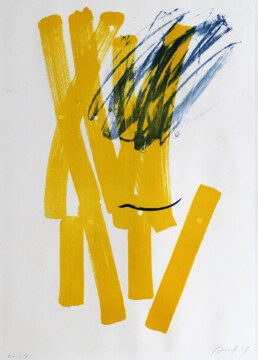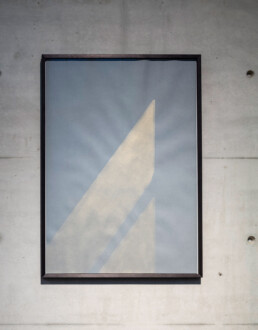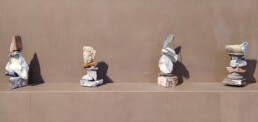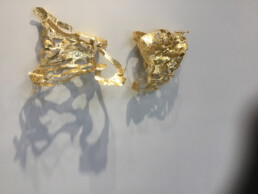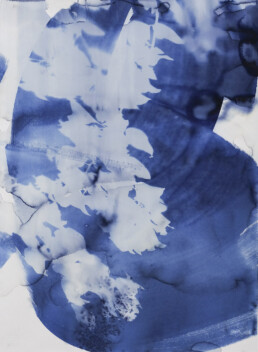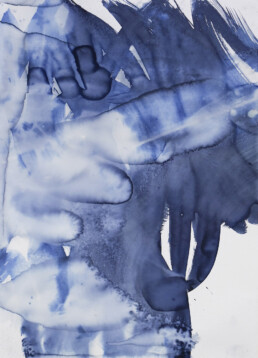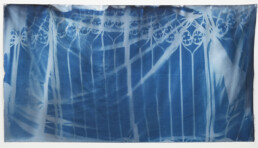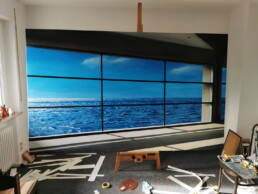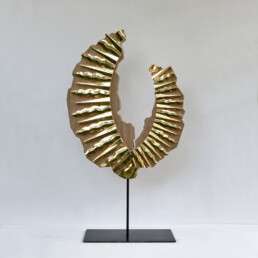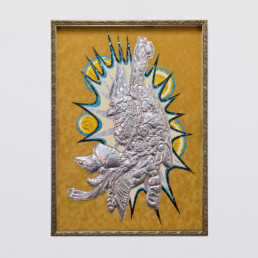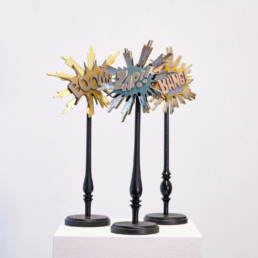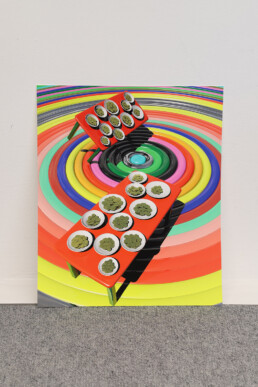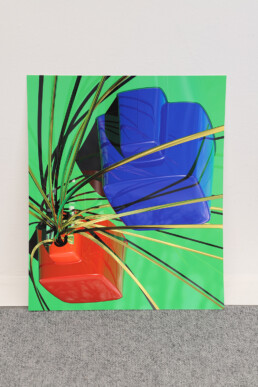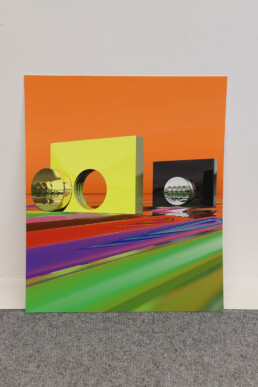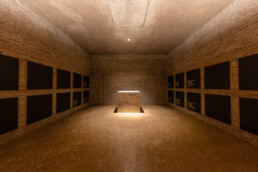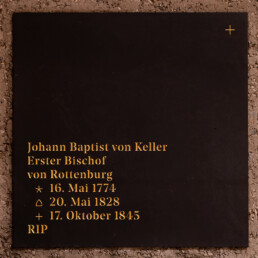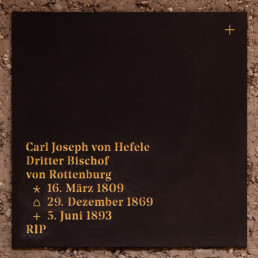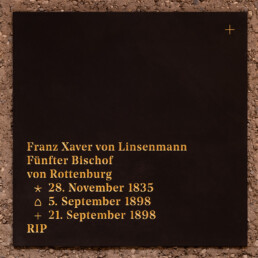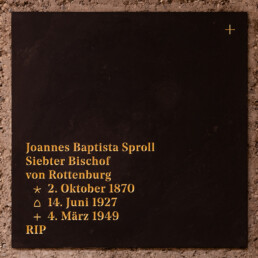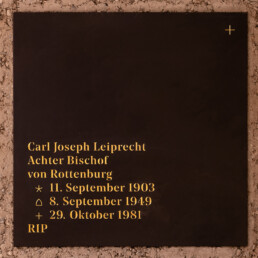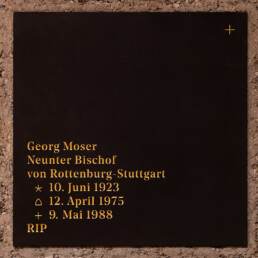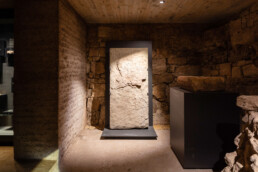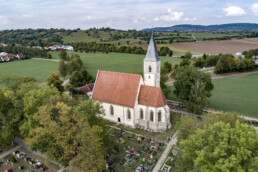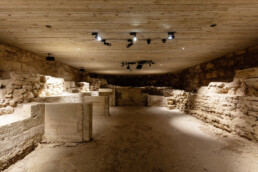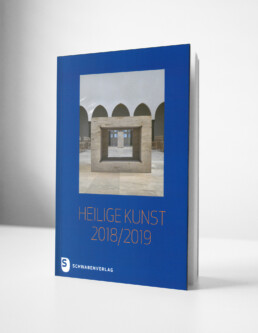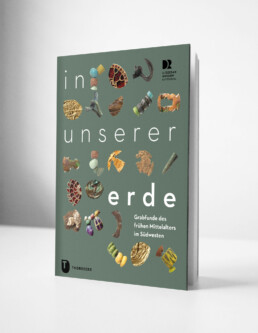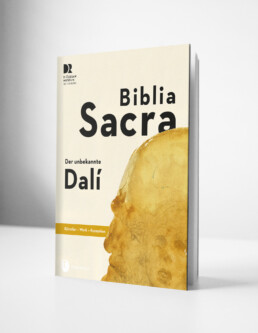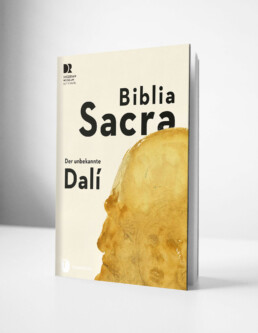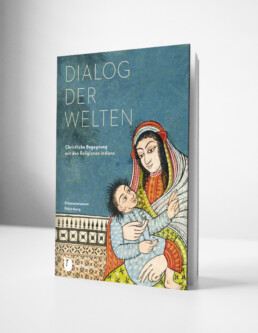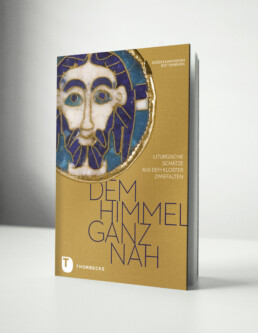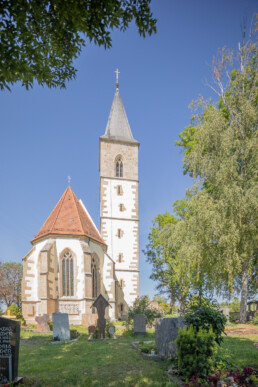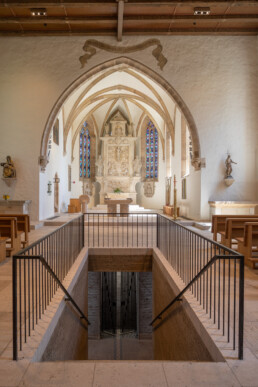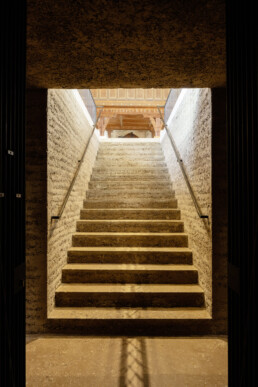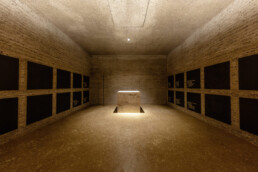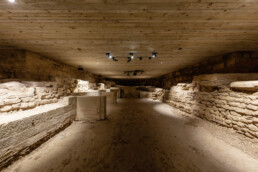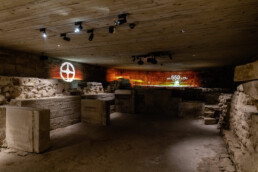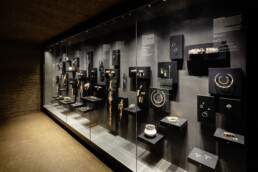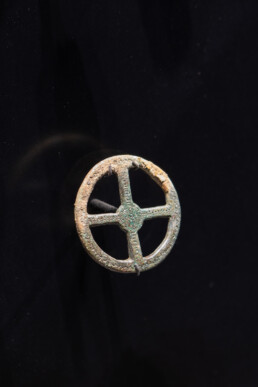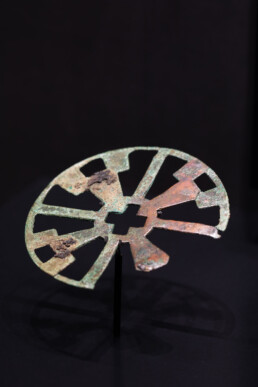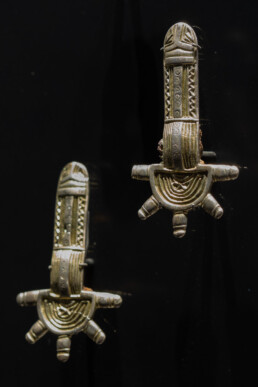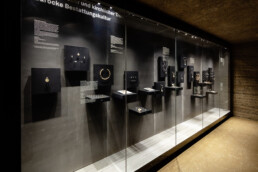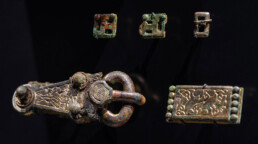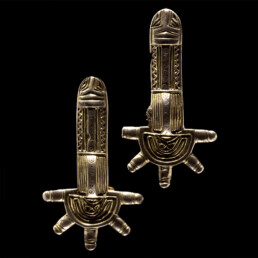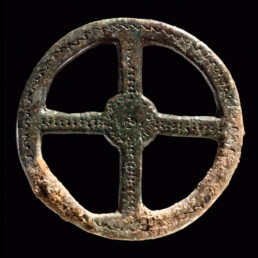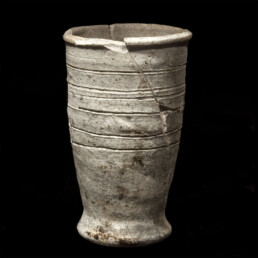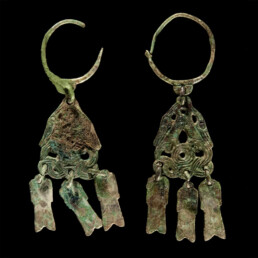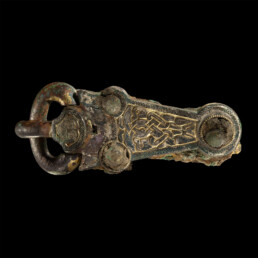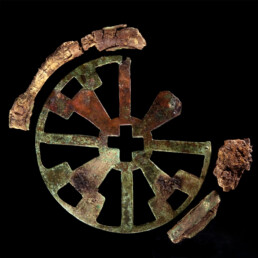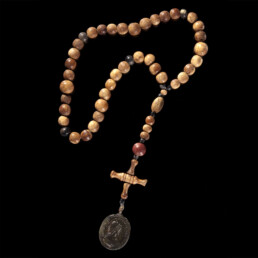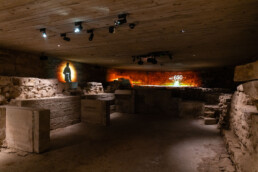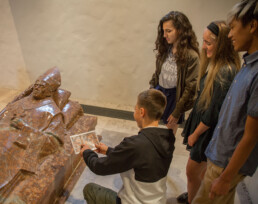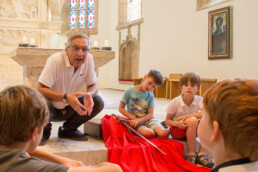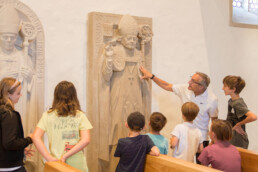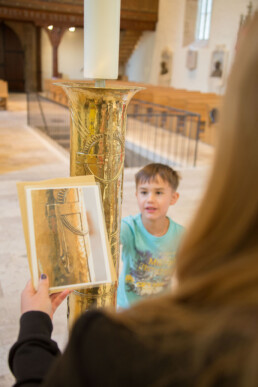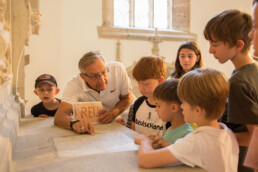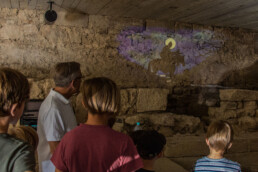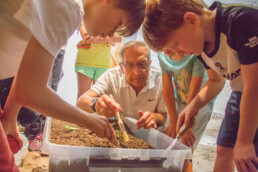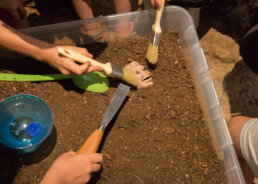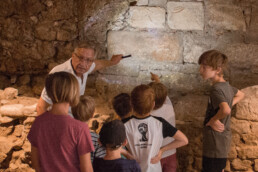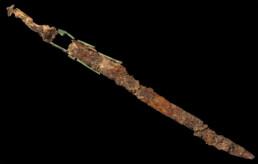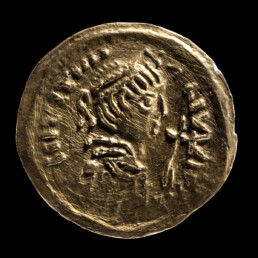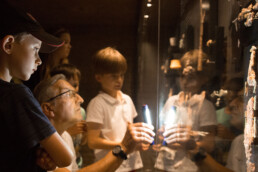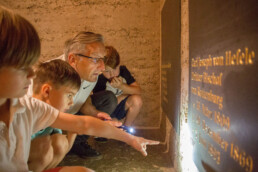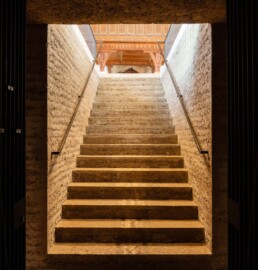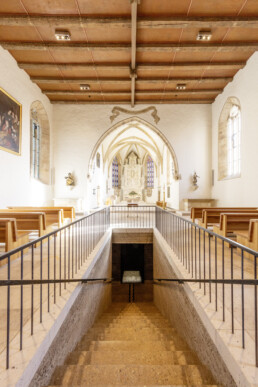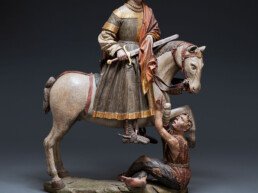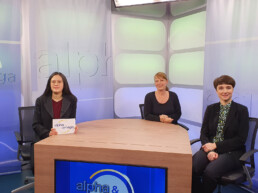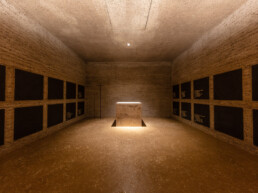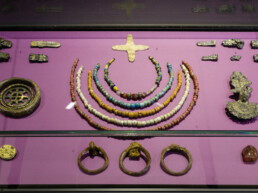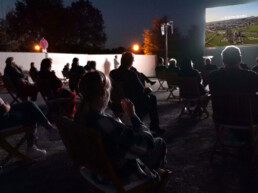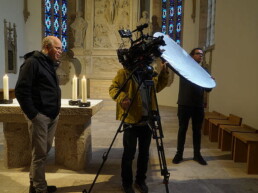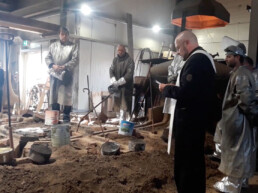Contemporary Art and Art Education
In January 2022, the new work area Contemporary Art and Art Education was founded.
The communication of Christian content through dialogue is an important pillar of the Diözesanmuseum Rottenburg. The work area Contemporary Art and Art Education deepens this dialogue by following the following objectives:
Establishment of a »contemporary art« collection area
The group of people who are familiar with traditional Christian iconography is steadily decreasing. Contemporary art corresponds to the views of visitors, especially the younger generation. It often deals with existential and thus always religious questions, which can be used to build bridges: Bridges to traditional visual art, but also bridges to Christian religious content. The artworks in the collection deal with these anthropological-existential questions in a surprising, inspiring and often interpretative way, each of which bears witness to the depth of the artistic debate.
Promotion of artists
Art and the church have had a close relationship for centuries. Important commissions for the decoration of churches went to artists who were ahead of their time and quite provocative. As a traditional cultural institution, the church can continue to offer artists a platform for their work and a financial basis for their activities.
Advice for church congregations
The artistic furnishing of a church is not a marginal matter. On the contrary, a high standard of aesthetics visually expresses appreciation for the sacred space. Historical identity and new orientation are reflected in the furnishings in equal measure. Faith biography and current faith situation find expression in art. Contemporary art is therefore an important topic for the parishes of our diocese. The work area »Contemporary Art« supports the parishes in an advisory capacity and brings them into dialogue with artists in order to enrich traditional ensembles through the permanent or temporary introduction of contemporary art: The artworks set accents, provide food for thought, are impulses for new forms of devotion and reinforce or question traditional furnishings in the space.
In recent years, cooperation and networking with diocesan institutions has been constantly expanded and conceptually developed. Parishes can benefit from temporary loans of the new collection. In order to make this accessible to diocesan institutions, it has been digitally recorded and presented in the form of an online inventory from the very beginning.
Inventory
Bishops‘ burial vault
The renovation work carried out from 2012, and the high medieval foundations discovered, resulted in the crypt being relocated to the west.
The Bregenz architecture firm Cukrowicz Nachbaur created a devotional space that is as simple as it is symbolic. This invites the viewer to dive into the depths of the site, where history, present and future are intertwined.
For the historically relatively young diocese, founded in 1821/28, the vastness of the Sülchen horizon is a stroke of luck: on the one hand, the predecessors of the incumbent bishop, including the prominent confessor, Joannes Baptista Sproll (1870-1948), are buried here; on the other hand, the rammed earth of the place constitutes a grounding from which the diocese’s roots can be experienced, going back to the beginnings of the Christian faith in Central Europe.
Owner
Diocese of Rottenburg-Stuttgart
Architects
cukrowicz nachbaur architekten ZT GmbH, Bregenz (AT)
Andreas Cukrowicz
Anton Nachbaur-Sturm
www.cn-architekten.at
in cooperation with Wiesler Zwirlein Architekten, Stuttgart
Exhibition design
merz merz, Stuttgart
Completion
2017
Architecture
During excavations in the course of renovation work in the late Gothic church (2012-2017), foundations of high medieval predecessor buildings were discovered. As a result of the significance of the archaeological finds, the bishop’s tomb was to be set up as a new lower church in the uncovered area under the nave and part of the foundations found was to be made visible within an archaeological exhibition area.
The design adopts the basic axially symmetrical structure of the existing sacred building. The free space created by excavations is occupied by a monolithic body and forms the new foundation for the nave. The path to the sepulchre follows the theme of slow immersion and prepares visitors for the central devotional space. At the level of the intermediate platform – with a view into the excavation area – the layout divides into two lateral flights of steps, which gently descend to the central main platform.
The devotional room with great room height is experienced as the concentration point of the entire complex and as a destination point with an altar block in the central axis; the bishop’s tombs are located in two superimposed levels along the longitudinal walls. All walls and ceilings were carved out in rammed earth construction. The monolithic body created in this way, with its layered formation process, corresponds to the structural composition of sedimentary rocks. The floors were also made of rammed earth, their surfaces lightly sanded. The grave slabs are made of Jurassic slate, the altar is a massive block of Gauingen travertine. The free-standing cross in the prayer room, the lattice gate to the archaeology area and the railing in the upper church are made of patinated brass, which harmonises with the earthy natural tones of the floor, wall and ceiling.
Architects
Andreas Cukrowicz (*1969) and Anton Nachbaur-Sturm (*1965) have been working together since 1992, initially in various collaborations and since 1996 in their joint office in Bregenz. Their portfolio includes numerous school, municipal and residential buildings, but also fire stations, a mountain chapel and 1st prize in the Konzerthaus München competition (2017). According to Otto Kapfinger, “(they) interpret tasks and materials from the context – precisely, simply and naturally. They bring complex requirements to unexpectedly clear and economical solutions with added value. They create robust, inspiring spaces for all the senses with wood, glass and concrete, with natural surfaces, with harmonious lighting and perfect proportions – strong and at the same time serene architectures for the unfolding of all of life’s spaces for action and play.” Both office partners have been involved for many years as design advisors in mostly Austrian municipalities.
Awards
German Architecture Award 2019
The Bishop’s Tomb received a recognition award from the German Architecture Prize in 2019.
“A conceivably small design task with extraordinarily great architectural power. Just a crypt, an archaeological site, prepared as a museum, and a burial vault for – also future – bishops. One cannot escape the sacral effect of this architectural gem. To apply the concept of innovation to the building would be to have failed to understand the architecture. Clay, a few pieces of iron for the fittings, brass for particularly significant furnishing details.
Only the purposefully sparsely used lighting is not one of the materials that was considered a customary building material until the modern age. This is why the architecture appears unaccustomed to the viewer. With the precise use of monochrome and hand-made floors, walls, stairs and ceilings, the architects succeed in bringing the visitors to a kind of inner contemplation, also to reflection. Of course, there is also technology, not visible, that serves security. Regardless of the technical apparatus: sustainable like all buildings that have been erected to stand for several centuries. A spiritual place, only actually visited by a few, by most because of the architecture. But a place that, inspired by the architecture, will inscribe itself in the atmospheric but also spiritual memory of visitors. Even if the task is limited within or below the existing nave (only the staircase exit is visible in the nave), the subterranean structure can be said to have a great radiance in the immediate surroundings and far beyond, simply through the knowledge of the significance of the site.”
(From the jury evaluation, Arno Lederer)
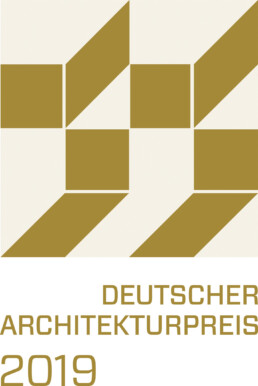
State Prize for Building Culture Baden-Württemberg 2020
In 2020, the Bishop’s Tomb received a recognition award from the Baden-Württemberg State Prize for Building Culture, which is only awarded every five years.
“Radical abstraction has led to a space here in which the mystery of transience and resurrection can be felt without the use of obtrusive symbolism.” In the Sülchen church, a flight of stairs connects the upper church with the exhibition areas below and the burial room, which is located one flight of stairs lower. The latter is the central point of the complex, designed as a prayer room with a large ceiling height: “The result is a coherent overall configuration of museum, burial chamber and renovated church,” says the jury.
The atmospheric mood is created by the targeted sequence of rooms, the use of rammed earth, Jura slate, travertine and brass, the coordinated colour tones, the brightness contrasts and the discreet lighting.
Archaeology and building history
The early medieval burial ground
Around or shortly after AD 550, a new cemetery was established on the outskirts of the early medieval settlement of Sülchen, initially perhaps only as a burial ground for the local manor.
A total of 78 graves from the second half of the 6th and the 7th century were recorded within the Sülchen church, with the burial ground certainly extending beyond the present church building to the west and south, possibly also to the east. An above-average number of grave goods show clear references to the Frankish Empire.
The Alamanni had been subjugated by the Franks in the early 6th century. Even though it is not known exactly how the Frankish takeover took place, it is assumed that groups of Franks settled in strategically favourable places. Sülchen was probably a flourishing settlement at this time on an important Roman road that was still in use and was a candidate for such a settlement. Since the Franks were already Christians in the 6th century, it is not surprising that individual grave goods can be interpreted as Christian.
The first church building
The construction of a church is regarded as definite evidence of early medieval Christianisation. A slightly trapezoidal hall was erected in a section of the early medieval cemetery, the broad foundation of which suggests a stone building. The stone building was erected around 680 at the latest, perhaps years or decades earlier.
An extension was added to the east side of the stone building before or at the latest around 750, which was almost certainly an indented rectangular choir. This created the characteristic ground plan of an early to high medieval church, so that the stone building may now also be called a church with certainty.
The second church building – the church of Count Hesso?
The small church, which was probably the local lord’s own church and at the same time the parish church of the settlement of Sülchen, was used without any archaeological changes until the early 11th century. Then, however, it was replaced by a new building, which was unusually large and representative for a village church of this time.
There is much to suggest that this generous new building was initiated by the Hessons, who have been documented as the Sülchgaugrafen since 1007. A transeptless three-nave pillar basilica with a three-apsidal choir end was built, which almost reached the dimensions of the late Gothic church.
The third church building – Romanesque new building or reconstruction?
In Romanesque times, the Sülchenkirche was given a new face. Whether only the foundations of the predecessor building were reused for the Romanesque church building or also larger parts of the rising masonry can hardly be judged, as the Romanesque church was almost completely demolished for the present late Gothic building. The few surviving spolia and other excavated decorative stones allow the Romanesque building to be dated between 1160 and 1180.
The previous design of a three-nave, transeptless pillar basilica with a three-apsidal choir end and its dimensions were retained in the Romanesque period. Only in the central apse could it be seen that the previous building was demolished down to the foundations and the apse was rebuilt. The choir took up a third of the total length of the church in the area of the nave – an astonishing phenomenon for a Romanesque “village church” (and later city parish church), which one would rather expect in monastery and collegiate churches and large city parish churches.
In the course of a later reconstruction, the two side aisles were vaulted. The central nave, on the other hand, is still flat-roofed.
The late Gothic new building
Today’s late Gothic church is a completely new building. It was built on almost the same footprint as the Romanesque predecessor church, which had previously been demolished. For the mixed masonry of the new building, the stone material of the previous building, which had been demolished except for very small remains, was used, namely Roman ashlars, which had already been used secondarily for the second building, and larger ashlars from the third, Romanesque church, as various decorated or painted spolia in particular emphatically show.
Around 1447 at the earliest, work began on the bell tower, the staircase tower to the east and the addition to the choir. The north and west walls of the nave were also built during this construction phase. After completion of the massive tower parts by around 1449/50, the nave with roof was completed by 1451.
This was followed by the construction of the choir, which was completed in 1454 with the completion of the roof.
An addition of the 19th century is the uppermost tower storey with a tent roof.
The history of the Sülchen church
Extensive archaeological excavations from 2012 onwards have recently led to new insights into its significance and history. Sülchen now presents itself as a burial site that dates back to the phase of Christianisation of Alamannia.
The oldest stone predecessor of the Sülchen church can be dated to around 650/680. With its cemetery and its early medieval predecessor buildings, the Sülchen church is one of the most outstanding sites of Christian history in today’s Baden-Württemberg.
Sülchen in the Early and High Middle Ages
Early medieval Sülchen existed at the latest since the 5th century. The Alamanni had settled north-east of the town of Sumelocenna, which had been abandoned by the Romans. In the Vita of Saint Meinrad, written around 900, the Sülchgau is mentioned as his home. The saint, who was murdered in 861 and over whose hermitage the monastery of Einsiedeln in Switzerland was to be founded in 934, came from a local noble family.
Shortly after the turn of the millennium, the Hessons are mentioned as counts of Sülchgau. They moved their centre of power to the Backnang area around the middle of the 11th century. The Sülchgau became less and less important and was mentioned for the last time in a document in 1057.
After the foundation of the town of Rottenburg
In the last quarter of the 12th century, the Counts of Hohenberg succeeded in acquiring property in the area around Sülchen. They founded the town of Rottenburg in 1280. The village of Sülchen was gradually abandoned. At the end of this development, only the Sülchen church and a few buildings belonging to it were to remain and bear witness to the once important settlement. With the flourishing of the town of Rottenburg, the pastoral care of the inhabitants quickly shifted to the Liebfrauenkirche. As early as the 14th century, the Sülchen priest was described as an “incuratus”, i.e. a priest without a pastoral mandate.
The Beguine Hermitage
Since the middle of the 14th century, there is evidence of a beguinage in Sülchen. Since the hermitage did not have its own chapel, the sisters, who had been affiliated with the Third Order of St. Francis since 1384, used the Sülchen church for their services.
It is reasonable to assume that the Beguines were active in funeral services, in commemorating and praying for the dead, and in tending the graves in the cemetery around the church.
The parish of Sülchen in the late Middle Ages
In the course of the 15th century, there was a growing tendency to transfer the parish rights still held by the Sülchen church to the market church in the town. It is therefore all the more astonishing that a new building of the Sülchen church was undertaken again in the years from 1447 onwards. It coincided with a phase in which the manorial circumstances were in a state of flux. In 1410, the county of Hohenberg, which had belonged to Austria since 1381, was pledged to an association of Swabian imperial cities under the leadership of Ulm. It was not until 1450 that Archduke Albrecht VI of Habsburg (1418-1463) succeeded in seizing the county of Hohenberg and its capital Rottenburg by force. In 1452 he gave the dominion of Hohenberg as a morning gift to his wife Mechthild of the Palatinate (1419-1482). The coats of arms of the Archduchy of Austria and the County of Hohenberg on the choir arch of the Sülchen church point to the sovereignty as the builder.
The Sülchen Church after the loss of parish rights
The process of transferring the parish rights to the Marktkirche was not prevented by the new construction of the Sülchen Church. In 1491, the translocation of the parish rights can be considered complete. Even though the designations in contemporary sources continued to fluctuate for a long time, the Sülchen church has since been regarded as a filial chapel of the Rottenburg Marktkirche in terms of ecclesiastical law. Sülchen was only occupied by one chaplain. Parallel to the transfer of the parish rights, the patrocinium was also transferred.
The Sülchen church had been a St Martin’s church, the chapel on the market originally a St Mary’s church (“Liebfrauenkapelle”). In a process that lasted for decades, the patrocinium of St. Martin was transferred to the Marktkirche, which was first documented as “St. Martin’s Church” in 1436. Conversely, the patrocinium of St John the Baptist has been documented for the Sülchen church since the 16th century. Beyond the loss of parish rights, the Sülchen church retained its function as a convent church. The Franciscan convent suffered from looting and destruction during the Thirty Years’ War.
In 1631 the hermitage was considered so destroyed that the sisters had to take temporary shelter in the city. In 1643 the Tyrolean Province of the Order decreed that the convent be merged with the Obere Klause in Rottenburg-Ehingen, so that monastic life in Sülchen ceased.
The Sülchen church retained its importance as a cemetery church.
The Sülchen church as the episcopal burial place
With the founding of a Württemberg state bishopric in 1821, Rottenburg became an episcopal see. In 1828, Johann Baptist Keller (1774-1845) was enthroned as Rottenburg’s first bishop. The simple parish church of St. Martin, the former market church, became Rottenburg Cathedral. Catholic tradition and canon law require bishops to be buried in their cathedral churches. However, St. Martin’s Church, which had been raised to the status of a cathedral without major construction work, did not have a corresponding crypt. When Bishop Keller died in 1845, he was therefore buried in the ordinary cemetery in Sülchen, which had become the sole burial place for the parish of St Martin after the Carmelite monastery was dissolved and the cemetery there was abandoned.
An initial application by the cathedral chapter to be allowed to set up a bishop’s crypt, if not under the cathedral, then at least under the Sülchen church, was initially rejected by the Württemberg state with reference to the fundamental ban on burial in churches. It was not until 1869 that the government approved such a crypt with the explicit justification that in a predominantly Protestant state it was desirable in the spirit of tolerance to also respect the Catholic tradition. The installation of the bishop’s crypt under the choir of the Sülchen church therefore also marks a step towards the increasing equality of the two Christian denominations in the Kingdom of Württemberg. It took the form of an architecturally unpretentious gallery crypt.
Museum
Concept
There, the uncovered architectural relics of Sülchen’s predecessor buildings – the apses of the Ottonian and Romanesque churches – are accessible. While the historical walls of the lower church are in themselves meaningful testimony, the new museum concept turns them into image and meaning carriers at the same time through a media presentation. Projections make the building history of the church, the extent of the early medieval burial ground, but also the everyday culture and the religious horizon of the people buried in Sülchen comprehensible.
The grave finds on display make it possible to look deeply into the history of Sülchen. In the Early Middle Ages room, under the title “Lebenswelt und Jenseitshoffnung. Grave goods of the Early Middle Ages”, rich grave furnishings from the middle of the 6th to the 2nd half of the 7th century are presented. The finds show that the area around Rottenburg was not only settled since prehistoric times, but was also one of the important sites of the Christianisation of Alamannia. The grave goods preserved from the late Middle Ages and the Baroque period are on display in a second room entitled “Private Mourning and Ecclesiastical Consolation. Baroque Funeral Culture”. They tell of the social status of the deceased and the burial rites of the time, but also show the change in ideals of office and sanctity as well as developments in lay and popular piety. All the grave goods open a window into the everyday world and culture of the people of past times and touch on a question of humanity that has lost none of its topicality beyond the change of historical epochs: the question of death and the afterlife, of “What comes after?”
The excavation and the singular archaeological finds combined with modern didactics make the history of Sülchen, a place rich in tradition, tangible for visitors in the museum part of the church. Thus, the Sülchen church is today a place of worship and at the same time a rich place of remembrance and experience.
Multimedia exhibition presentation
So that the grave goods found in the Sülchen church do not remain silent, visitors can expect an impressive multimedia presentation in the lower church.
There, not only historical data but also the respective people, their everyday culture and their horizons of faith come to life. Image projections and audio recordings make excursions to other art locations, bring important historical personalities up close and let renowned experts have their say. The museum exhibition of the Sülchen treasures is a branch of the Diocecan museum Rottenburg.
Team
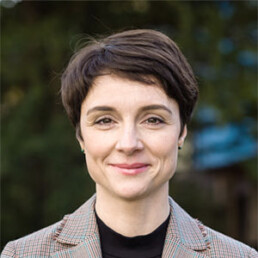
Diocesan Conservator Dr. phil. Melanie Prange
Direction
Phone: +49 (0) 7472 922-180
museum@bo.drs.de
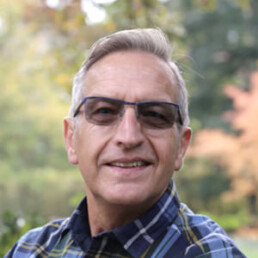
Matthias Raidt
Scientific assistant
Guided tour registrations by phone
Mo–Fr, from 9–12 Uhr
phone: 0160 1635388
mraidt@bo.drs.de
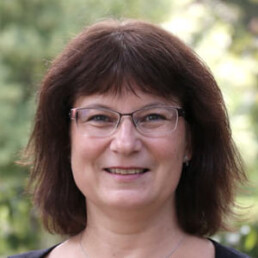
Hildegard Weidenauer
Secretary
phone: 07472 922-180
HWeidenauer@bo.drs.de
Guides: Andrea Bachmann, Matthias Reuther, Jörg Widmann
Publications
Impressions
With the 3D panoramic tour, or our collection of video documentaries on the Sülchen church.
Press
Press photos for download (after enlarging, save the image with the right mouse button or download all images as a ZIP archive [95MB]).
Excavation finds
Site of Christianisation
The Sülchen excavations have made it possible to look deep into the early times of the German southwest and thus considerably expand our knowledge of the Christianisation of southwest Germany. The finds from around eighty graves show that the area around Rottenburg was not only inhabited since prehistoric times, but can also be counted among the important sites of the Christianisation of Alamannia. The grave goods from the 6th and 7th centuries, which the soil revealed and which are now being presented to the public in the newly built Sülchen Museum, illustrate an epochal transition: a girl’s grave contains a Charon’s penny, which was presumably given to the deceased according to pre-Christian custom as ferry money for her journey to the afterlife, as well as early Christian evidence. Thus, the cross amulets express faith in Jesus Christ as the Risen One and reveal a gradually spreading Easter hope.
Among the early medieval burial treasures, which show striking references to Burgundy and the Frankish Empire, are precious decorated belt buckles, swords, knives and lances from men’s and boys’ graves as well as rich women’s jewellery with combs made of bone, strings of beads made of iridescent coloured glass and brooches. All these finds fascinate us in two ways: they open a window into the everyday world of the people of this distant time and at the same time touch on a question of humanity that has lost none of its topicality beyond the change of historical epochs – the question of death and the hereafter, of “What comes after?”
Walk through the eras
Not only the time of early Christianity is made present by the Sülchen finds: the following epochs have also left striking traces of their piety and a rich artistic heritage. Around 1000, a three-nave pillar basilica with a three-apsidal choir was built in place of the first church (around 680). This building was part of the cultural and spiritual upswing of the Ottonian period, for which magnificent works of art are characteristic. Liturgy, art and the claim to lordly sacral representation through church architecture made “a great leap” forward. This upswing, initiated in Sülchen by the noble family of the Hessons, continued into the Romanesque period. The present building of the Sülchen church dates from the middle of the 15th century and still breathes the atmosphere of urban late-medieval piety and provision for the afterlife.
The building also contains important Baroque artifacts – such as the painted epitaphs of Rottenburg noble and bourgeois families from the 17th century. The enduring burial tradition can be seen in the numerous graves of that era, which in turn yielded finds of cultural historical significance: The priests’ graves, for example, reveal the changing ideals of office and sanctity.
The same applies to lay and popular piety, the development of which is illustrated by numerous Baroque grave objects, including shab figures, saint medallions, Sebastian crosses and votive figures.
Almost a year has passed since the reopening of the Sülchenkirche in Rottenburg. Since then, visitors can visit the burial chamber with the deceased bishops and admire treasures from times gone by. Despite the reopening, investigations into the excavation treasures continued, and we were able to view some of them in September 2018.
Mediation and Education
Guided tours
With expertise through the Sülchen church in Rottenburg
Public guided tours
Dates for public tours usually take place on Sundays. You can find all dates in our schedule.
Registration: currently required
Duration: approx. 60 minutes
Admission fee: 5,- Euro per person (children up to 12 years free).
Meeting point: main portal of the church
Contact
Matthias Raidt M. A.
Phone: 0160 1635388
Mail: MRaidt@bo.drs.de
Individual guided tours
Guided tours for groups are available on request.
Admission fee: 25,- EUR plus 3,- EUR per person (children up to 12 years free).
The space in the exhibition area allows only a limited number of participants, currently 15 per tour.
Please plan two guided tours for larger groups.
As the Sülchen church still functions as a cemetery church, no guided tours can take place between 1 pm and 3.30 pm.
Children and young people / day care centre and school
Events for children and young people are held regularly.
You are also welcome to book guided tours for children or young people, e.g. with archaeological practice.
Entrance fee: 3,- EUR per person (children up to 12 years free)
The boy with the sword and the girl with the gold coin
A real archaeologist, who was also present at the excavations in Troy, shows and explains the history and secrets in Sülchen to children and young people.
First we uncover mysteries in the ancient church, then we go really deep down to the excavations – and there the girl and the boy are waiting. Both have brought back a lot of things from their time, and that then begins to tell.
Visit
Opening hours
The bishop’s crypt and the upper church can be visited during the opening hours of the Sülchen church:
- daily (except Tue and Wed): 8 a.m. to approx. 6 p.m.
- Tue: 9 to approx. 18 h
- Wed: 12 to approx. 18 h
- Regular church service: Tue, 7 p.m.
The museum part of the Sülchen Church is only accessible with a guided tour.
Admission prices
Public guided tours:
5,– EUR per adult
3,– EUR adults (reduced) and pupils 12 years and older
Children up to 12 years free
Individual guided tours:
Duration approx. 60 minutes
up to 20 persons:
35,– EUR plus 3,– EUR per person
Children up to 12 years free
21 persons and more:
Divided into 2 tours
50,– EUR plus 3,– EUR per person
Children up to 12 years free
Guided tours for children and young people:
3,– EUR per person
children up to 12 years free
Guided tours for schools:
1,– EUR per pupil
Duration of tour approx. 60 minutes
Children’s birthday party – adventure tour:
50,– EUR
Duration approx. 90-120 minutes
from 8 children
Age: 10–14 years
Please have the entrance fee ready on site.
Around your visit
The lower church is accessible only by stairs.
Sanitary facilities are available on the cemetery grounds.
Gastronomic offer in Rottenburg
Directions
Address: Sülchenstreet (near the Sülchen cemetery), 72108 Rottenburg am Neckar.
By car, parking facilities
The Sülchen church is located at the end of Rottenburg in the direction of Wurmlingen. Free parking is available for visitors right next to the Sülchen church and the Sülchen cemetery.
By public transport
The bus stop “Rottenburg Friedhof Sülchen” is directly in front of the Sülchen church. From here you can take bus line 18 to the centre of Rottenburg as well as to Tübingen main station every hour.
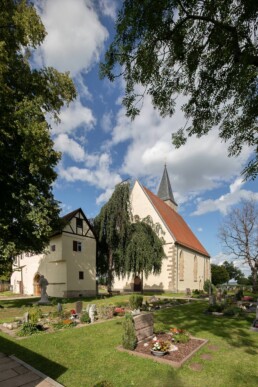
Welcome at the Sülchen church
Sülchenkirche is open
Guided tours of the Sülchenkirche take place on Sunday afternoons at 2.30 pm.
Our digital offer “Treasures from the Sülchen Church” will continue to introduce you digitally to the world of early medieval Sülchen.
Sülchen has served as a burial site for about 1,500 years. The finds discovered during the most recent archaeological excavations (2011-2017) are outstanding evidence of Christian piety – from the Early Middle Ages to the Baroque.
The church (mid-15th century) also derives its significance from its use as an episcopal burial ground since 1869. The historic crypt was abandoned in the course of the last restoration, thus making the remains of two predecessor buildings (around 1000 / 1120/30) accessible to visitors.
The new crypt – a prayer room built in rammed earth under the church longhouse – was designed by the Bregenz architectural firm of Cukrowicz Nachbaur. The appeal of the architecture lies in the tension between the contemporary aesthetics and the deep historical and religious symbolism.
The Diocesan Museum makes the historical significance and the variety of uses of Sülchen tangible in an annual special guided tour programme. Children should also be able to experience the richness of the place in a vivid way. Therefore, the museum also offers special dates for our young visitors.
We invite you to a virtual tour
Public tours and events
Duration: approx. 60 minutes
Dates: usually Sunday, 2.30 p.m.
Meeting point: Main portal of the Sülchen church.
Admission fee:
Adults: 5 euros
Adults (reduced) and pupils from 12 years: 3 euros
Children up to 12 years free
Please have the entrance fee ready on site.
